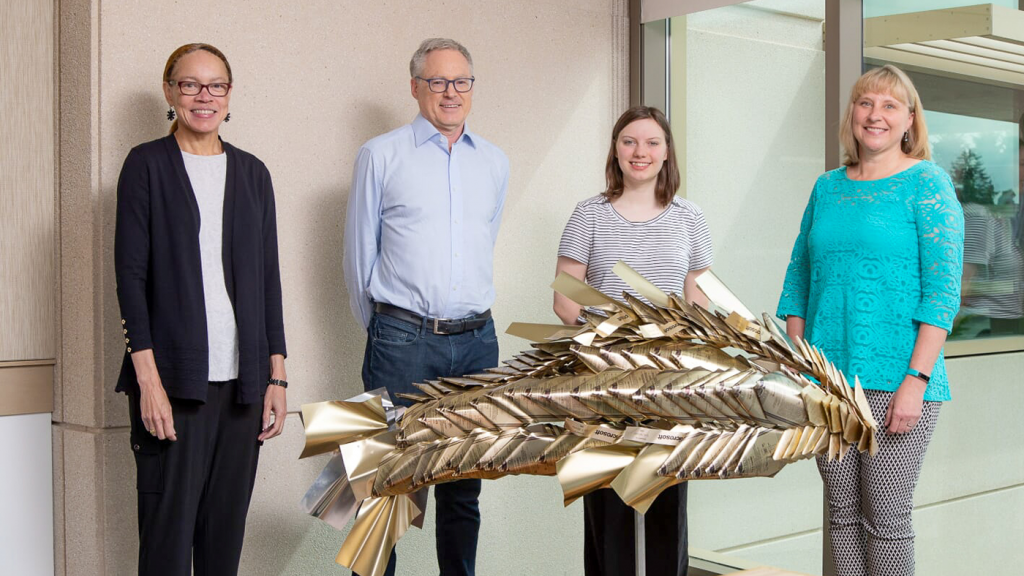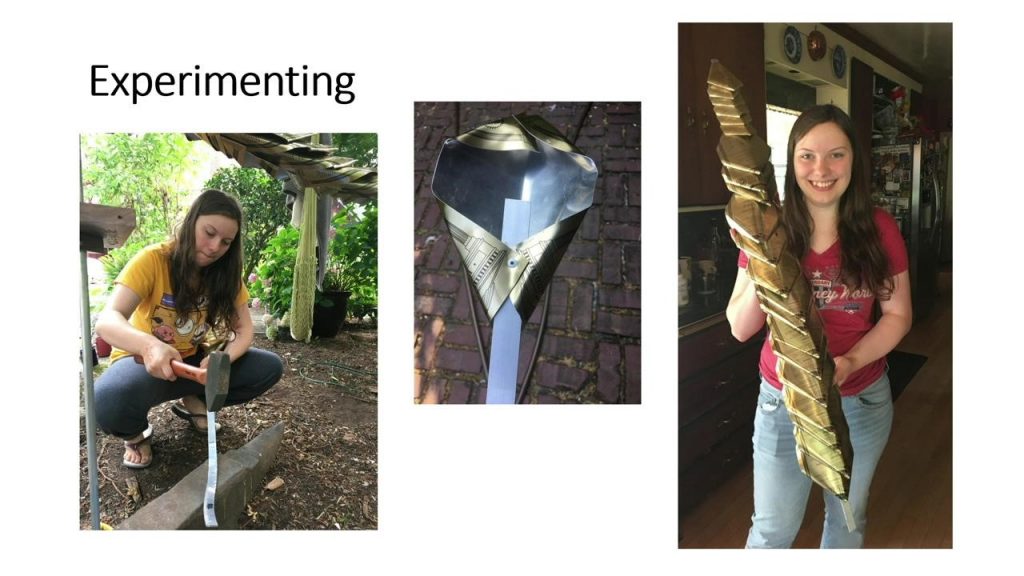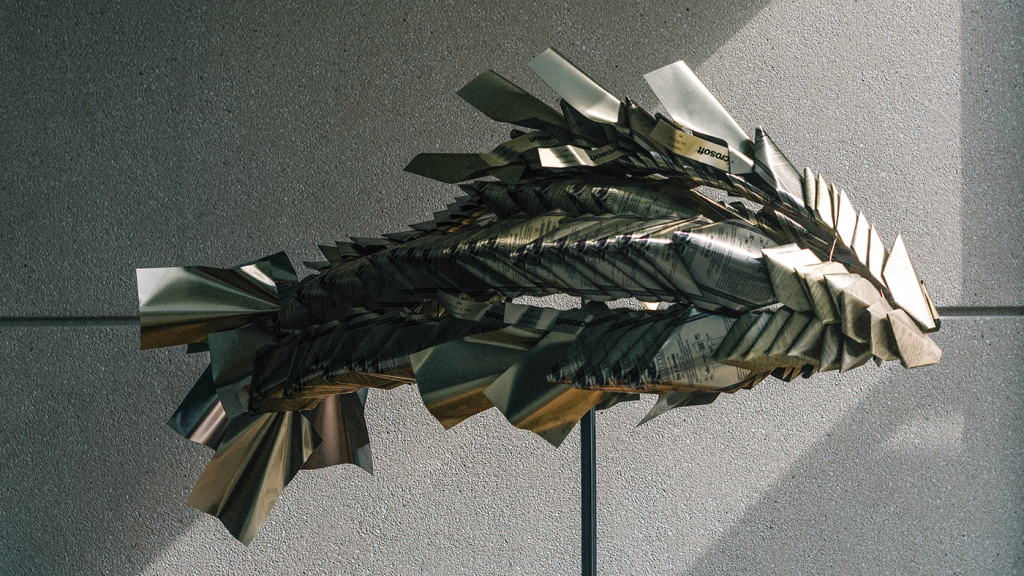This post has been republished via RSS; it originally appeared at: Microsoft Research.

Microsoft Assistant General Counsel Sandy Swain; Eric Horvitz; Charlotte Day; and Microsoft Associate General Counsel Danielle Johnston Holmes.
Technical Fellow and Director of Microsoft Research Eric Horvitz was completely floored as he spun around and spied the stunning sculpture that had silently been wheeled in behind him. The evening’s gathering had been arranged to celebrate a special birthday. His wife, Mary, had just motioned to him to come join her as she prepared to deliver remarks to friends that had gathered at their home.
But now, he stood before a dazzling and dramatic fish, its glittering scales fashioned from what appeared to be gold, its body imbued with grace and motion. What was this beautiful creation? His wife whispered the answer to his question in his ear, and Horvitz couldn’t contain his laughter.
A year earlier, during a garage spring-cleaning, Horvitz had given the go-ahead to discard boxes full of the commemorative plaques he’d received over the past 25 years whenever a patent for his innovations had been granted by the United States Patent and Trademark Office. He’d assumed it would be the last he’d see of the plaques.
Horvitz could never have imagined all of them turning around and swimming back to him—reborn and transfigured into a powerful visual metaphor for invention, collaboration, and the sharing of knowledge.
Unbeknownst to her husband, Mary Horvitz had had a plan for the plaques.
“Eric shared reflections from time to time about various projects at Microsoft Research that he was excited about and their influences,” she said. “Although he agreed to let the plaques go, I knew they represented important sets of ideas and collaborations with his colleagues. I sensed that there was an opportunity to create a meaningful sculpture from the plaques.”
She set out to find an artist. By chance, she mentioned this search to Amy Day, a friend and the mother of a budding young artist, Charlotte Day. Mary Horvitz learned about Charlotte’s interests and of her special talent as an artist. She sensed that Charlotte was the right choice.
Charlotte and Patent One
If the plaques represented a quarter century’s worth of innovations, Charlotte Day’s vision of their future metamorphosis was immediate.
“When I first saw the plaques, the image of a fish jumping out of the water popped instantly into my head,” recalled Day.
Though she would spend several more months considering other ideas, she ultimately was drawn irresistibly back to the concept of the leaping fish. In the spring of 2018, she began sketching ideas and soon realized she was going in the right direction.
The undertaking was an enormously complex one, replete with technical challenges at every level. She’d originally planned to keep the bronze sheets flat, but a designer friend encouraged her to bend the metal. It was a revelation.
“It was like seeing a fourth dimension,” she recalled.
The skeletal structure of the fish would be fashioned from aluminum bars, hammer bent in opposite directions, that would be attached to and supported by the walnut backs of the awards, which would serve as the piece’s base.

According to Day, the fish represents the progress of technology and is swimming through seas of innovation and discovery.
As with any work of creation, there were good days and bad days, bursts of progress and excitement and dark moments.
“When I was in the middle of it, I thought, ‘I’ve made a mistake; I’m doomed,’” recalled Day. “I thought I was going to fail and not have anything for Eric’s celebration. But when faced with difficulty, perseverance is key. And when you finally make it to the end, everything is worth it.”
Day gratefully credits her father with helping her on a number of the technical solutions for holding the fish together.
She ended up arranging the scales so they best displayed the information originally contained on the plaques, starting with the earliest patents at the head of the fish and working backward toward their later cousins, the chronological fanning representing how earlier accomplishments and discoveries can lead the way to future ones. She ended up using 172 plaques in all.
She named it Patent One.
According to Day, the fish represents the progress of technology and is swimming through the seas of innovation and discovery. And Eric Horvitz is not the only name on the plaques; there are other names across the progression of the scales, showing how creative people working together can change the direction of the fish’s swim.
Day, who will become a student at the Savannah College of Art and Design in Savannah, Georgia in the fall, expressed her appreciation for having been chosen as the artist for the project. “I’m so grateful to Mary, Eric, and Microsoft Research for this wonderful opportunity and for being open to the innovation and many talents of different types of people—creatively inspired engineers and artists alike,” said Day. “I am so honored to have been trusted to represent Eric’s work at Microsoft in a piece of art.”
Celebrating an art acquisition—and more
Patent One was recently celebrated at a reception in its new home–Microsoft Research Redmond–attended by Day and her family, as well as leaders from the patenting and intellectual property team at Microsoft and leads at Microsoft in art and design.
As the throng of guests walked about, admiring the glowing creation and other pieces of Day’s art, Day gave a presentation about her journey of creation. Horvitz also presented, focusing on the ideas and efforts behind a few of the golden scales of the fish to give attendees a sense for the deeper meaning of the glistening surface of Patent One.
Horvitz began his remarks with a brief history of patents and the goal of patent systems to provide incentives to inventors to share their innovations with the world rather than hiding them.
“Science thrives on collaboration and sharing,” Horvitz told the attendees. “Patents were invented to nurture and share societally valuable information that people would otherwise hoard, keep to themselves as trade secrets.”
He emphasized the wording of the very first patent act in a young United States to illustrate this idea—an act for the encouragement of arts and sciences.
Horvitz then reviewed the ideas and technology futures captured in four of the scales. He zoomed in on scales representing efforts from the 1990s: (1) the first junk email filter method and prototypes powered by machine learning; (2) the first methods for prioritizing email messages by their time-sensitivity using machine learning and natural language processing and the Priorities prototype that provided users with a prioritized inbox and that routed time-sensitive messages to mobile devices; (3) the combination of natural language processing, machine learning, speech recognition, and dialog to recognize and work in a mix of initiatives with end users on tasks and goals recognized in email messages and the Lookout prototype that was built to demonstrate the ideas; and (4) the embedding of accelerometers and other sensors to make mobile devices sensitive to tilt and touch and demonstrations of these signals in context-sensitive services, gaming, and in the rotating and reformatting of text. Years later, the iPad and iPhone would popularize some of these ideas around tilt and touch after Apple gained a license to use Microsoft patents in a patent portfolio swap.
While Horvitz may have been stunned to learn how many patents had his name on them—he holds over 250 U.S. patents—the wealth of innovations present in the body of the fish is no surprise to Horvitz’s colleagues who oversee intellectual property and patenting.
“Eric is our most prolific inventor at Microsoft, and we really appreciate his partnership and contributions over the years,” said Danielle Johnston Holmes, the Associate General Counsel who oversees the Microsoft intellectual property portfolio. “Eric’s patents have had impact at Microsoft. We have used them defensively to deter and counter accusations of patent infringement against Microsoft, and we have used them to broker deals with other companies to further our business goals. As an added bonus, they have now contributed a fun and unique piece of art to our campus.”
Reflections
Horvitz couldn’t be more inspired by Day’s sculpture. He sees it as a beautiful symbol of the creative, risky pursuit of advances in scientific research and development.
“We tend to celebrate the technical details of advances and breakthroughs at Microsoft Research and other tech-oriented centers,” he said. “But some of the most successful technical advances arise from insightful collaborations that incorporate imagination, artistry, psychology, and humanism. And nurturing possibilities into reality is done under great uncertainty—and risk of failure. Charlotte’s feat of artistry and engineering and the process she went through with envisioning, experimenting, re-envisioning, and establishing key collaborations to create Patent One have multiple layers of meaning for me,” he explained.
Reflecting on the past 25 years, Horvitz recalled that when his grad-school-era AI startup was acquired by Microsoft in 1992 and he committed to joining a young Microsoft Research, he told himself he would stay at Microsoft for a maximum of six months—“just long enough to get to know leaders at the company and then to continue on with my goal of going to a university,” he said with a chuckle.
Today, he feels as if he’s just getting going. “And things are getting better all the time, now with the win-win of a less cluttered garage, dusty boxes of plaques transformed into a beautiful and meaningful piece of art, and an empowered young artist readying to head to college and to take on the world.”
The post Swimming in creative waters: A young artist, an inventor, and a nurturing sea of family and colleagues appeared first on Microsoft Research.


